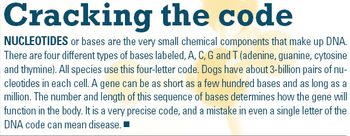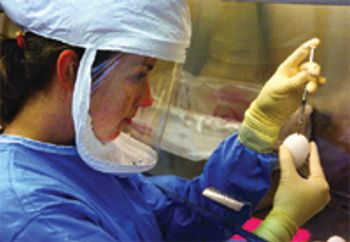
Spring. It's finally here. The daffodils are blooming. The hyacinths are up. The dogs come in almost every day with muddy paws, so I have semi-permanent footprints on the window sills where they peer out to see who's coming.

Spring. It's finally here. The daffodils are blooming. The hyacinths are up. The dogs come in almost every day with muddy paws, so I have semi-permanent footprints on the window sills where they peer out to see who's coming.

This month, we all benefit from Dr. Karen Tobias' dedication to teaching and bettering the standard of care in veterinary medicine.

Purina Pro Plan has reformulated its entire line of senior cat foods to address the changing nutritional and physiological needs of aging cats in two phases of the senior life stages.

Allpro Imaging introduces Provecta V, an accent digital intraoral sensor that incorporates Bluetooth technology and the ScanX 12 DVM digital processor.

Cleveland ? Universal Medical Systems Inc.'s Vet-MR Grande?, the first dedicated dual-purpose magnetic resonance imaging (MRI) system for all small and large animals, was unveiled at the North American Veterinary Conference (NAVC).

Feline Radio-Iodine Center introduces radio-iodine therapy for feline hypothyroidism, the company says.

Herndon, Va. - Creating a charitable fund for use within the practice is a good way to let client and veterinary practice dollars work within the community, says Dr. Bill Swartz of Clocktower Animal Hospital.

Securos announces the release of a new line of casting and splinting products OrthoCast and OrthoSplint.

Deoxyribonucleic acid (DNA), a.k.a. the molecule of life, harbors an estimated 20,000 to 200,000 canine genes hidden in the DNA across from 38 pairs of chromosomes, all contributing to health and disease. Sleuthing out defects along genes nucleotides, or base pairs, seemingly turns into a numbers game that can add up into the billions.

Neogen Corp. introduces DC&R disinfectant reported to effectively control avian influenza, the company says.

Wall Street Detectives unveils its Avitar DNA collector, which gathers forensic DNA from equines using saliva.

Spix Publishing announces the release of Clinical Avian Medicine, an avian medicine and surgery text.

Duluth, Ga. - Merial launched a Previcox experience trial to collect post-approval data in a broader population of dogs and provide greater clinical experience data for veterinarians.

Advent Product Development introduces the Snap Needle, a self-swaging needle system.

Nestl? Purina has created new dental health diets that reduce tartar with customized kibble size and complete nutrition for daily feeding of adult dogs and cats.

Synbiotics Corp. introduces Ovucheck? Premate Equine, a semi-quantitative ELISA test for the measurement of progesterone in one drop of blood. The test can be used on-site to give information regarding the presence or absence of a functional corpus luteum in mares.

Millsboro, Del. ? Intervet introduces Leventa? (levothyroxine sodium) oral solution, an alternative to oral tablets for canine hypothyroidism.

National Report - Media reports on avian influenza have fanned the flames of hyperbole among the lay press in much of the world, and public officials aren't doing much to quell fears, either.

Neogen Corp. introduces a Companion Loyalty Program for veterinary professionals.

DVM BPA 12-05

New York ? Pfizer's immunomodulator Zylexis? is now available in the United States for horses after almost a decade of use and patient data in Germany.

Pets Best insurance for pets, introduces Pet Vet-Talks, an online community section of its Web site, www.petsbest.com, to communicate with pet owners on timely topics of interest concerning companion animals.

Kansas City ? Bayer Animal Health is enhancing its popular Web site, BayerDVM.com.

Securos introduces the Titan External Skeletal Fixation System.

Iams ? Tartar Treats? are tasty edible dental chews with a unique texture that doesn't crumble, the company reports.

Jorgensen Laboratories introduces heavy-duty bronze or pewter urns with threaded, screw-on lids or bases for security.

We don't want what is happening in human medical professions to spill over into veterinary medicine.

Vetlab Supply introduces a combination UV light and pen.

IDEXX Laboratories introduces its VetLab? Station laboratory information management system (LIMS).